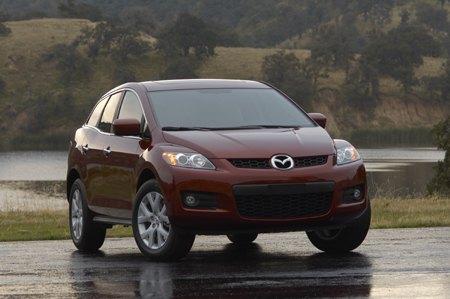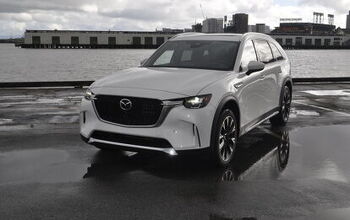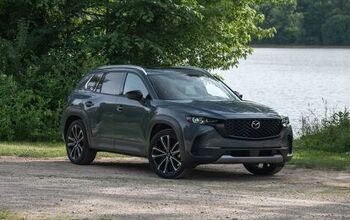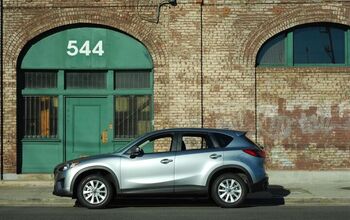Mazda CX-7 Review
If any mainstream brand can build an SUV that handles like a sports car, it’s Mazda. The Japanese automaker has a proven track record of developing vehicles with superior agility and dynamic appeal. Little wonder that ads for Mazda’s new CX-7 imply that it drives like a sports car, and that most junket-based reviews of the new “crossover” verify the claim. Well, I’ve driven the CX-7 and I’ve driven sports cars and the CX-7 is no sports car.
Looking at Mazda’s new crossover, you’d be forgiven for thinking otherwise. The CX-7 combines the MazdaSpeed6’s big-grilled nose, the RX-8’s protruding fenders, a laid-back windshield and a complete absence of straight lines. While the sporty-looking result distances the CX-7 from the mainstream of SUV design, the relentless surface effects deployed to disguise the machine’s fundamental portliness don’t meld into a coherent whole. More to the point, aerodynamics do not driving dynamics make.
The CX-7’s cabin comes closer to realizing the intended car-like gestalt. While a liberal application of hard, ungrained plastic risks placing passengers in econobox Hell, artful styling and metal-effect trim yield an intriguingly ultra-modern atmosphere (at least in the black interior). The Grand Touring model even adds a nifty strip of faux alligator hide down the center of each seat. The CX-7’s instrument cowl signals the machine’s sporting intent, while the heavily stylized dash does an admirable job of hiding the raked windscreen’s acres o’ dash effect.
Thanks to its relatively low driving position and prominent center console, the CX-7’s cockpit feels more athletically honed than the more open cabins of competing crossovers. (Some will simply find it tight.) But the CX-7’s front seats provide a clue that the model’s pistonhead proclivities may be less than advertised; the comfortable chairs don’t provide much lateral support. In back, there's about as much legroom as you'll find in the average midsize sedan, but shoulder room is a bit tight for three across. Buyers drawn to SUVs in search of elbow room won’t be happy. The CX-7’s 58-cube cargo bay is about 20 shy of the class average, but still sufficient for lifestyle schlepping or a weekend away.
The CX-7’s direct-injected, turbocharged DOHC four (borrowed from the MazdaSpeed6) stumps up 244 horses. While the output is generally sufficient for everyday progress, the powerplant fails to kick those fillies out of the stable with any alacrity. A firm press on the CX-7’s go pedal from a dead stop yields… nothing much. (Think boost lag combined with old school DOHC behavior; the 3,000 rpm torque peak is high for a turbo.) Buzz the four over 3500 rpm, where your ears definitely won’t mistake it for a six, and the CX-7 finally starts to get a move on. But even then the crossover’s two-ton curb weight and power-sapping, slow-reacting six-speed slushbox deny enthusiastic drivers sufficient thrust to justify opting into the new genre. The manual shift mode takes off some of the wait, but not enough.
In casual driving, the CX-7’s handling lives up to its billing. In gentle turns, body lean is well controlled. The steering is quick with a hint of tactile feedback. Unfortunately, tall 60-series sidewalls muffle communication from the contact patches and slow transitional responses, hobbling this sports car wannabe’s dynamic feedback. Shod the beast in lower profile tires and it might actually feel agile.
Press on and the whole fast driving thing falls apart. The crossover’s nose drifts wide, its steering feel goes AWOL and the chassis’ limited composure becomes apparent. The best vehicles seem to shrink and shed pounds when driven hard. The harder you push the CX-7, the heavier and clumsier it feels. But you won’t want to push it very hard, anyway, as the Goodyear Eagle RS-A’s on the outside front corner howl in protest at the slightest provocation. Ignore the complaining and you’ll find that there’s still plenty of grip available. But the noise! The noise! The noise! You’ll suffer less squealing at a children’s book reading.
Once calm is restored, the CX-7’s ride is moderately supple and quieter than that of other Mazdas. Credit those generous sidewalls. The CX-7’s softcore suspension tuning should make highway trips a breeze and back country roads with sweeping curves a joy. But caning the crossover around the tightly wound two-laners that feature prominently in the Japanese company’s ads? Forgeddaboutit.
Let’s face it: it doesn’t matter who makes an SUV or how they tune the chassis. A sports car is a low-slung, properly balanced vehicle with razor-sharp reflexes. SUVs are too high and too heavy to provide even a remotely similar driving experience. Mazda ought to know better. As the progenitors of the superb MX-5 and tightly focused RX-8, they should know that there’s only one sort of vehicle that drives like a sports car: a sports car.
[Michael Karesh operates www.truedelta.com, a vehicle reliability and price comparison website.]
Michael Karesh lives in West Bloomfield, Michigan, with his wife and three children. In 2003 he received a Ph.D. from the University of Chicago. While in Chicago he worked at the National Opinion Research Center, a leader in the field of survey research. For his doctoral thesis, he spent a year-and-a-half inside an automaker studying how and how well it understood consumers when developing new products. While pursuing the degree he taught consumer behavior and product development at Oakland University. Since 1999, he has contributed auto reviews to Epinions, where he is currently one of two people in charge of the autos section. Since earning the degree he has continued to care for his children (school, gymnastics, tae-kwan-do...) and write reviews for Epinions and, more recently, The Truth About Cars while developing TrueDelta, a vehicle reliability and price comparison site.
More by Michael Karesh
Latest Car Reviews
Read moreLatest Product Reviews
Read moreRecent Comments
- Formula m How many Hyundai and Kia’s do not have the original engine block it left the factory with 10yrs prior?
- 1995 SC I will say that year 29 has been a little spendy on my car (Motor Mounts, Injectors and a Supercharger Service since it had to come off for the injectors, ABS Pump and the tool to cycle the valves to bleed the system, Front Calipers, rear pinion seal, transmission service with a new pan that has a drain, a gaggle of capacitors to fix the ride control module and a replacement amplifier for the stereo. Still needs an exhaust manifold gasket. The front end got serviced in year 28. On the plus side blank cassettes are increasingly easy to find so I have a solid collection of 90 minute playlists.
- MaintenanceCosts My own experiences with, well, maintenance costs:Chevy Bolt, ownership from new to 4.5 years, ~$400*Toyota Highlander Hybrid, ownership from 3.5 to 8 years, ~$2400BMW 335i Convertible, ownership from 11.5 to 13 years, ~$1200Acura Legend, ownership from 20 to 29 years, ~$11,500***Includes a new 12V battery and a set of wiper blades. In fairness, bigger bills for coolant and tire replacement are coming in year 5.**Includes replacement of all rubber parts, rebuild of entire suspension and steering system, and conversion of car to OEM 16" wheel set, among other things
- Jeff Tesla should not be allowed to call its system Full Self-Driving. Very dangerous and misleading.
- Slavuta America, the evil totalitarian police state





































Comments
Join the conversation
All I know is that compared to the CRV the CX-7 is more comfortable, drives better, and feels like it isn't powered by kittens. It makes the CRV look very very bad, and the mileage isn't much worse. It may not be a sports car, but it is a helluva small SUV or CUV or whatever.javascript:document.getElementById('commentform').submit();
I own a CX-7, my wife and I bought it over a compromise, I wanted a fast car and she wanted an SUV. We took the middle ground. Even thought I wanted the smaller "sports" car I love the cargo room. The CX-7 has plenty of torque at 2500-3000 rpm's, it lags for a second (0-2500 rpms) and then boom. In full auto mode the car tries to shift to 5th gear at 40 MPH so it can appear a little sluggish. Keeping the CX-7 in the right gear is the key to all the joy I have with this car, 3rd gear and any speed above 35 the CX-7s power is very apparent. The little lag in the power from a stop I think has a lot to do with being automatic and not a true manual. I put a CAI in it and that helped a lot. There are other aftermarket parts for it. I know a couple of people that have it running 0-60 in 6 seconds with simple bolt on up grades. The handling is great for a car its size and weight. I think the review about the CX-7 should have been titled "the truth about cars' advertisement". . I also own a Eagle Talon TSi with plenty of power, so I think I can give a fair opinion. Maybe the CX-7 isn't a sports car, but it is a sporty crossover.